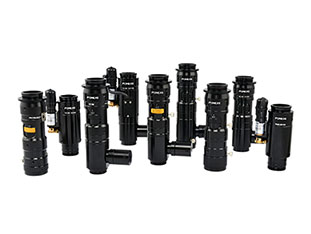
The types of optics used in an image measurement program are varied, depending on the characteristics of the measurement object, the measurement accuracy required, and the working environment. The following are some of the common types of optical lenses used in image measurement:
1. Zoom lens
Vari-focal lenses have a wide range of zoom functions and can quickly adjust the focal length in a very short period of time to accommodate inspection targets of different distances and sizes. For example, POMEAS industrial zoom lens has a significant advantage in the field of image measurement, its zoom function makes the photographer or surveyor only need to adjust the focal length once, you can quickly carry out a variety of distances of the measurement work, greatly improving the work efficiency and accuracy.


2. Telecentric lenses
Telecentric lenses are mainly used in the field of precision measurement and inspection, and are designed so that the optical axis of the lens is parallel to the normal to the surface of the object, thus reducing measurement errors due to changes in the distance between the lens and the object. Telecentric lenses are suitable for applications that require extremely high measurement accuracy.


3. Microscope heads
Microscope heads are characterized by high magnification and high resolution, and are able to clearly present details of tiny objects. In image measurement, microscope heads are often used for precise measurement and analysis of tiny parts, cells, fibers, and so on.
4. Fixed-focus lenses
Fixed focus lenses have a fixed focal length and are suitable for measurement tasks at specific distances and ranges. Although fixed-focus lenses are more limited than zoom lenses in terms of adapting to different measurement targets, they are still used in certain specific application scenarios due to their stability and high resolution.
5. Wide angle lens
Wide-angle lenses have a large field of view and are capable of capturing a wider field of view. In image measurement, wide-angle lenses are suitable for measuring and monitoring large objects or scenes.
When selecting optical lenses, it is also necessary to consider factors such as the type of lens interface, working distance, field of view, spectral characteristics, aberration rate, and the size of the mechanical structure. In addition, with the lens selection matching the camera selection is also critical, need to consider the camera's photoreceptor chip type, video characteristics, signal output interface and operating mode and other factors.
Product recommendation
TECHNICAL SOLUTION
MORE+You may also be interested in the following information
FREE CONSULTING SERVICE
Let’s help you to find the right solution for your project!

- APPICATION CASE
- RESOURCE CENTER
- DOWNLOAD CENTER
SOLUTIONS SUPPORT
- ZOOM LENS SELECTION TOOL
- TELECENTRIC LENS SELECTION TOOL
- FA LENS SELECTION TOOL
- ZOOM RATIO TABLE
- CERTIFIED MODEL
SELECTION TOOL
- WHY POMEAS
- FAQ
- PRIVACY POLICY
- TERMS OF USE
- DELIVERY & RETURN POLICY
CUSTOMER CARE
 ADDRESS
ADDRESS
Add.:No.68, Chongwei Road, Baizhoubian, East district, Dongguan, China, 523000
CONTACT
 Tel:+ 86-0769-2266 0867
Tel:+ 86-0769-2266 0867
 Fax:+ 86-0769-2266 0867
Fax:+ 86-0769-2266 0867
 E-mail:marketing@pomeas.com
E-mail:marketing@pomeas.com

Wechat QR code

 ASK POMEAS
ASK POMEAS  PRICE INQUIRY
PRICE INQUIRY  REQUEST DEMO/TEST
REQUEST DEMO/TEST  FREE TRIAL UNIT
FREE TRIAL UNIT  ACCURATE SELECTION
ACCURATE SELECTION 